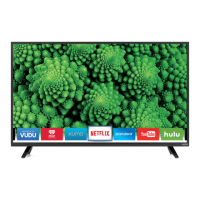English - 27
The TV displays “No Signal.
• Be sure your connected devices are turned on.
• Press the INPUT button on the remote and select the input to which your device is connected (HDMI-1, HDMI-2, COMP, etc.).
There are black/gray bars on the top/bottom/sides of the screen.
• Note that some television channels add black bars to the picture.
• Set the TV to Wide or Zoom mode. Press the WIDE button, highlight Wide or Zoom, and press OK.
• Adjust the video settings of your external device
There is no power.
• Be sure the power cord is securely connected to the AC socket on the TV and to a working electrical outlet.
• Press the POWER button on the remote or on the side of the TV.
• If the above steps do not work, try plugging the power cord into a dierent outlet.
The V.I.A. App is not working.
• Be sure your TV is connected to the Internet.
• Restart the App by pressing the EXIT button to close the App, then open the App.
• Reboot your TV by pressing the POWER button on the remote, then turn it back on.
I am having trouble connecting to my network.
• If you are using an Ethernet cable, ensure it is securely connected to your router/modem and the TV.
• If you are connecting wirelessly, try repositioning your router for the best connection.
• Turn o all devices. Restart your router/modem.
• Try to use another internet-connected device. If it is not working, call your Internet Service Provider (ISP).
The remote is not responding.
• Make sure the batteries are properly inserted, matching the - and + symbols.
• Replace the batteries with fresh ones.
Regulatory Information
FCC Class B Radio Interference Statement
NOTE: This equipment has been tested and found to comply with the limits for
a Class B digital device, pursuant to Part 15 of the FCC Rules. These limits are
designed to provide reasonable protection against harmful interference in a
residential installation. This equipment generates, uses and can radiate radio
frequency energy, and if not installed and used in accordance with the instructions,
may cause harmful interference to radio communications. However, there is
no guarantee that interference will not occur in a particular installation. If this
equipment does cause harmful interference to radio or television reception, which
can be determined by turning the equipment o and on, the user is encouraged to
try to correct the interference by one or more of the following measures:
• Reorient or relocate the receiving antenna.
• Increase the separation between the equipment and receiver.
• Connect the equipment into an outlet on a circuit dierent from that to which
the receiver is connected.
• Consult the dealer or an experienced radio/TV technician for help.
This device complies with Part 15 of the FCC Rules. Operation is subject to the
following two conditions: (1) this device may not cause harmful interference, and
(2) this device must accept any interference received, including interference that
may cause undesired operation.
Notice
The changes or modications not expressly approved by the party responsible for
compliance could void the user’s authority to operate the equipment.
Shielded interface cables and AC power cord, if any, must be used in order to
comply with the emission limits.
The manufacturer is not responsible for any radio or TV interference caused by
unauthorized modication to this equipment. It is the responsibilities of the user
to correct such interference.
FCC Warning
Changes or modications not expressly approved by the party responsible for
compliance with the FCC Rules could void the user’s authority to operate this
equipment.
Canada Notice for License-Exempt Radio Apparatus
This device complies with Industry Canada’s license-exempt RSSs. Operation is
subject to the following two conditions: (1) This device may not cause harmful
interference, and (2) this device must accept any interference received, including
interference that may cause undesired operation.
This device operates on a no-protection no-interference basis. Should the user
seek to obtain protection from other radio services operating in the same TV
bands, a radio license is required. Please consult Industry Canada’s document
CPC-2-1-28, Optional Licensing for Low-Power Radio Apparatus in the TV Bands,
for details.
Cet appareil est conforme aux CNR exempts de licence d’Industrie Canada. .
Son fonctionnement est sujet aux deux conditions suivantes:
1. le dispositif ne doit pas produire de brouillage préjudiciable, et
2. ce dispositif doit accepter tout brouillage reçu, y compris un brouillage
susceptible de provoquer un fonctionnement indésirable
Cet appareil fonctionne sur une base sans protection et sans interférence.
Dans le cas où l’utilisateur cherche à obtenir de la protection des autres
services de radio fonctionnant sur les mêmes bandes TV, aucune license est
requise. Veuillez consulter le document CPC-2-1-28 d’Industrie Canada, License
optionnelle pour les appareils radio de faible puissance, pour plus de détails.
Industry Canada Class B emission compliance statement
This Class B digital apparatus complies with Canadian ICES-003. Cet appareil
numérique de la classe B est conforme à la norme NMB-003 du Canada.
Declaración de México:
La operación de este equipo está sujeta a las siguientes dos condiciones: (1)
es posible que este equipo o dispositivo no cause interferencia perjudicial y (2)
este equipo o dispositivo debe aceptar cualquier interferencia, incluyendo la
que pueda causar su operación no deseada.

